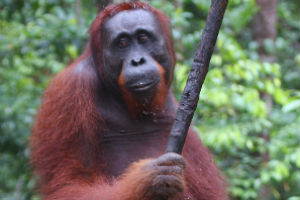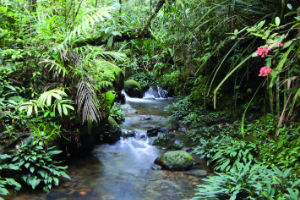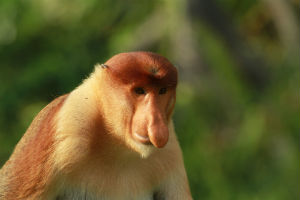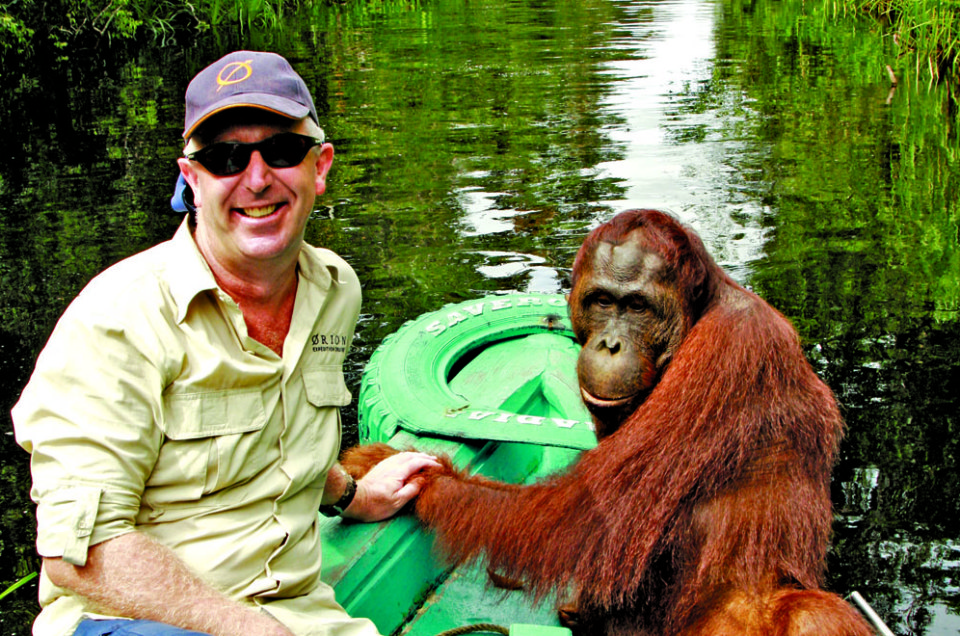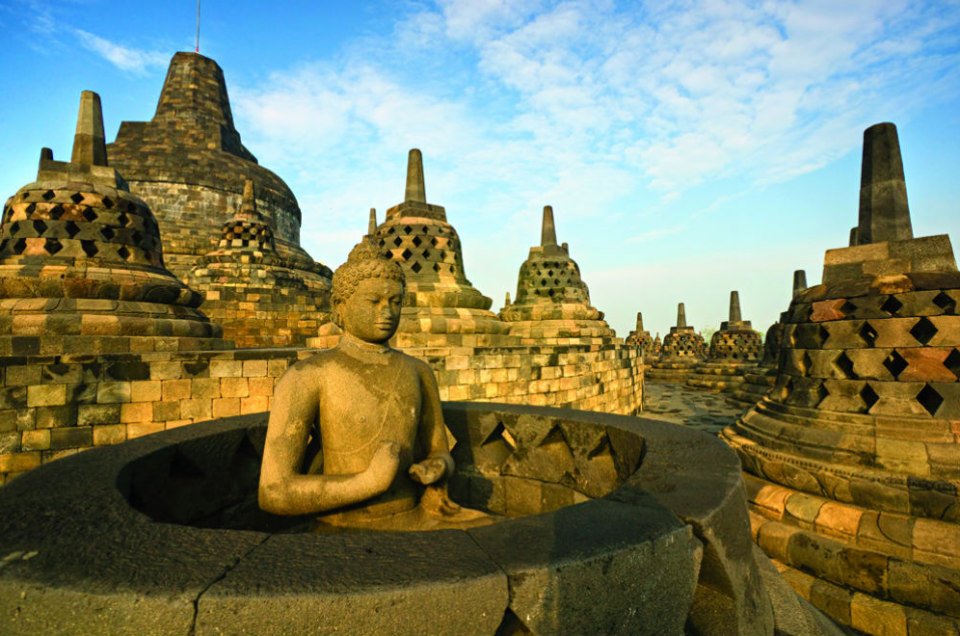Our on-deck sumptuous seafood dinner had been cancelled, but thanks to Borneo’s torrential tropical rain we could barely hear the announcement. Soggy barbecues were not our priority at that point, as we could hardly see our cruise ship as we bobbed in the dinghy while lightning ripped across the sky. Crackles and rumbles from the angry sky sent a shiver through us as we waited to return to on board after an excursion into the Klias Wetlands. We’d signed up for an adventurous nine-day expedition cruise around Sabah, on the island of Borneo, but storm-chasing was a new addition to the itinerary.
You have to expect the unexpected when you’re travelling to remote areas and it’s essential to pack an adventurous spirit along with your sunglasses and camera. Borneo is divided into the northern Malaysian states of Sarawak and Sabah, where our cruise started in the city of Kota Kinabalu, the independent sultan state of Brunei and the southern Indonesian part of the island.
When we arrived the air was ripe with the tang of sun-drying fish and at the local market elderly men furiously clacked away on vintage Singer sewing machines with a cigarette clamped between their lips.
My mother and I, both not natural born explorers, were travelling with luxury adventure cruise line Orion Expedition Cruises and we were welcomed at Kota Kinabalu with champagne and canapés to begin our expedition in style. Borneo is most famous for its gentle endemic orangutans, but it’s also home to a diverse range of wildlife from comical-looking proboscis monkeys, to the colorful hornbill birds and gigantic monitor lizards.
Our first encounter with the local animals was on our first excursion to the Klias Wetlands. Orion’s zodiacs ferried us to a jetty, where a bumpy bus ride took us deep into the mangrove rainforest to catch a small speedboat into the heart of the wetlands for some primate-spotting. Proboscis monkeys are not as famous as orangutans, but they are as endangered and after spotting the males – with their big bellies and droopy red noses – as they gathered their harem of females, it was hard not to fall in love with them.
It was heartening to see so many monkeys along the mangrove-entwined banks of the river; calling to each other and hurling themselves through the mango and hibiscus trees. Closer to the river’s edge we saw huge monitor lizards sunning themselves on branches and high above us red-beaked hornbills glided over our heads. All these sightings made the subsequent storm-chase back to the ship more than worthwhile – especially when, dripping wet, we were welcomed back on board with a vodka cocktail to calm our nerves.
There was no need for nail-biting zodiac rides at our next port when we docked at Labuan Island; a federal territory that takes its name from the Malay word for anchorage. Most of Orion’s passengers are Australian, so they were more familiar than us with the WW2 history of this island off the coast of Sabah. Labuan was ceded to Britain in 1846 from Brunei, before being occupied by the Japanese during the war and then liberated by the Australians on 9th September 1945. It was a poignant tour for many of the Australians as we visited the Commonwealth war graves and wandered amongst the bird of paradise flowers in the Japanese peace park.
Borneo’s history is a fascinating one and back on the main island of Borneo we travelled from the town of Kudat to meet the indigenous Rungus people. They live in communal ‘longhouses’ in northern Borneo and we saw a reconstructed one made of palm leaves and bamboo stalks at Bavanggazo and visited a modern one in Tinagol made of MDF and iron.
Local people were also on hand to welcome us at the idyllic tropical island of Pulau Mantanani. Traditional dancing, which involved jumping over moving bamboo stalks and blowing darts, took place in a small sandy clearing near the white beach. Children took us along a pebbly path to their village, where Orion were providing supplies to the school, and villagers watched over smoking barbecues laden with squirrel fish as we met with students. The heat and humidity were intense, so a snorkel safari out to a nearby lagoon to spot purple anemone was a welcome relief – as was the shore-side barbecue and bar. We were treated to another island stop later on in the cruise at the tiny jungle-covered Pulau Lankayan, where the ‘house reef’ that surrounds it is home to rainbow-colored parrot fish, blue starfish and even a baby black-tipped shark.
It was time to return to spotting our land-dwelling wildlife and the city of Sandakan, site of a famous POW camp during WW2, was our base for several days as we headed out into the heart of the jungle. Near Sandakan is Labuk Bay, a proboscis monkey reserve on a huge palm plantation. It’s a sad fact that much of Borneo’s rainforest has been cleared to make way for these plantations, which create palm oil for use in Western food and cosmetics. At Labuk Bay we saw our old friends the proboscis monkeys, double-beaked hornbills and macaques who were trying to steal food from the feeding platforms.
One of the highlights for many passengers was a visit to the Sepilok Orang Utan Rehabilitation Centre to observe the orangutans at the feeding stations. Set up in 1964, the largest orangutan rehab centre in the world works with orphaned orangutans (coming from the Malay ‘man of the forest’) to teach them how to feed, climb and play before releasing them into the wild. It was a privilege to watch them as they ate their lunch and the visit heightened our anticipation for an overnight adventure down the Kinabatangan River.
A speed boat took us several hours inland up the cocoa-colored river where jungle-clad banks were home to white egrets and plenty of proboscis monkeys straddling the branches. We refueled at a riverside restaurant, with a lunch prepared by local villagers, and sped on to our overnight lodge. Before bed an evening cruise rewarded us with more monkeys and monitor lizards, as well as a saltwater crocodile the length of our little boat, majestic crested serpent eagles and electric blue kingfishers. We went to sleep with the sounds of the jungle drifting in through the slatted shutters; hoots, calls and the gentle patter of rain.
In exchange for an early start the following day we were gifted with fantastic wildlife spotting. First a gibbon attracted our attention, then a big group of hornbills added a splash of color to the trees, while datar birds and brahminy kites flew over lakes clogged with purple water hyacinths. But we were all holding our breath for an orangutan sighting.
We’d seen some orangutan nests the night before, but no movement, so when our guide pointed out a distinctive orange arm hanging from a tree we were all ecstatic and two more sightings of the gentle giants filled our hearts, and our memory cards, with joy. There had been plenty of exciting adventures along the way, but this is what we’d all really wanted to see here. Borneo’s wildlife, alive and kicking, in the heart of the jungle.
